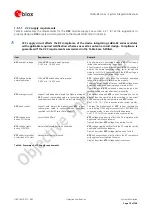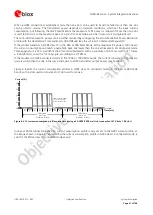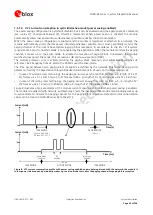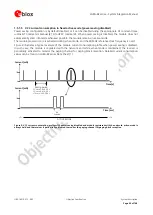
LARA-R2 series - System Integration Manual
UBX-16010573 - R02
Objective Specification
System description
Page 33 of 148
Item
Requirements
Remarks
Impedance
50
nominal characteristic impedance
The impedance of the antenna RF connection must match the 50
impedance of the
ANT2
port.
Frequency Range
See the
LARA-R2 series
Data Sheet
The required frequency range of the antennas connected to
ANT2
port depends on the operating bands of the used cellular module and
the used Mobile Network.
Return Loss
S
11
< -10 dB (VSWR < 2:1) recommended
S
11
< -6 dB (VSWR < 3:1) acceptable
The Return loss or the S
11
, as the VSWR, refers to the amount of
reflected power, measuring how well the antenna RF connection
matches the 50
characteristic impedance of the
ANT2
port.
The impedance of the antenna termination must match as much as
possible the 50
nominal impedance of the
ANT2
port over the
operating frequency range, reducing as much as possible the amount
of reflected power.
Efficiency
> -1.5 dB ( > 70% ) recommended
> -3.0 dB ( > 50% ) acceptable
The radiation efficiency is the ratio of the radiated power to the power
delivered to antenna input: the efficiency is a measure of how well an
antenna receives or transmits.
The radiation efficiency of the antenna connected to the
ANT2
port
needs to be enough high over the operating frequency range to
comply with the Over-The-Air (OTA) radiated performance
requirements, as the TIS, specified by applicable related certification
schemes.
Table 8: Summary of secondary Rx antenna RF interface (ANT2) requirements
Item
Requirements
Remarks
Efficiency
imbalance
< 0.5 dB recommended
< 1.0 dB acceptable
The radiation efficiency imbalance is the ratio of the primary (
ANT1
)
antenna efficiency to the secondary (
ANT2
) antenna efficiency: the
efficiency imbalance is a measure of how much better an antenna
receives or transmits compared to the other antenna.
The radiation efficiency of the secondary antenna needs to be roughly
the same of the radiation efficiency of the primary antenna for good
RF performance.
Envelope
Correlation
Coefficient
< 0.4 recommended
< 0.5 acceptable
The Envelope Correlation Coefficient (ECC) between the primary
(
ANT1
) and the secondary (
ANT2
) antenna is an indicator of 3D
radiation pattern similarity between the two antennas: low ECC results
from antenna patterns with radiation lobes in different directions.
The ECC between primary and secondary antenna needs to be enough
low to comply with radiated performance requirements specified by
related certification schemes.
Isolation
> 15 dB recommended
> 10 dB acceptable
The antenna to antenna isolation is the loss between the primary
(
ANT1
) and the secondary (
ANT2
) antenna: high isolation results from
low coupled antennas.
The isolation between primary and secondary antenna needs to be
high for good RF performance.
Table 9: Summary of primary (ANT1) and secondary (ANT2) antennas relationship requirements















































